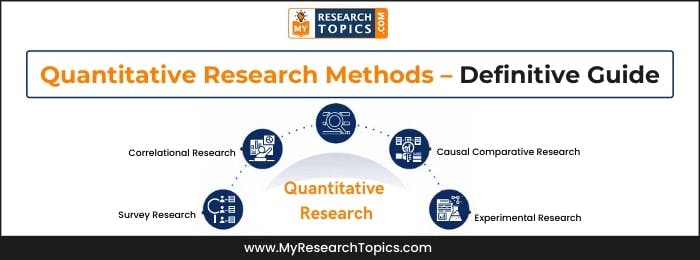Quantitative Research Methods – Definitive Guide
Published 16 October, 2023

Research is basically a progressive study that involves the collection, analysis, and interpretation of data. The main objective of the study is to discover the relationship between different types of variables. There are different types of research such as Qualitative and Quantitative. In this article, we will provide you with an explanation of Quantitative research.
What is Quantitative Research
Quantitative research is a systematic study of the phenomenon. It is a type of research that includes a collection of numerical data. In such kind of research, the researcher generally uses statistical and mathematical techniques for analyzing the information. In Quantitative research, the researcher collects facts from existing and potential clients by implementing sampling techniques in research. The other methods which the researcher utilizes for gathering information in Quantitative research are online surveys, Questionnaires, online polls, etc. Quantitative research produces numerical results that can be helpful in predicting the future of goods or services.
For instance, the researcher is performing a study for gathering the information about the amount of time which medical professional takes in diagnosing and treating single patients. An investigator in order to gather information has designed the patient satisfaction survey template.
Quantitative research is most appropriate for conducting for gathering information related to the field of social sciences. Researcher generally uses the statistical technique for gathering Quantitative information. In quantitative research methods, statisticians deploy mathematical frameworks and theories that pertain to the quantity under question. By performing Quantitative research you will be able to obtain logical and unbiased. The researcher uses structured methods for collecting data. You for performing the quantitative research need to select a large sample from the population.
Read Also: Overview of Qualitative and Quantitative Research
Methods of Doing Quantitative Research
The key characteristic of Quantitative research is that it is basically data-oriented. There are basically two techniques that you can utilize for performing Quantitative Research these are :
- Primary Quantitative Research Methods
- Secondary Quantitative Research Methods
I. Primary Quantitative Research Methods
The most popular approach to performing market research is primary quantitative research. Primary research differs from secondary research in that it focuses on actually collecting data rather than relying on data from prior studies. In addition to the process flow, the primary quantitative research design can be divided into three main tracks. These are:
A. Techniques And Types of Studies for Primary Quantitative Research
There are multiple types of primary quantitative research. They can be divided into the four main approaches shown below:
1. Survey Research
Survey research is basically the most fundamental tool among different Quantitative Heracles methodologies. If you are performing a survey, then you need to ask questions from sample respondents. You can utilize a number of techniques like online polls, questionnaires, and surveys for gathering information. By executing survey research, the researcher can accumulate information about the customer view and help the organization in making the product development-related decision. It is a type of research that you can execute on a particular target group. A prerequisite for this type of research is that the sample of respondents must have randomly selected members. As it is a tactic that will help you in maintaining and ensuring the accuracy of results. You can use a random sampling technique for selecting participants.
2. Correlational Research
The main objective of conducting correlational research is to develop an understanding of the relationship between two different elements. It is correlational research that will also help you in analyzing the effect of one variable in the study on others. You in order to conduct correlational research need to select two different groups. An investigator mainly performs Quantitative research for correlating two or more variables using mathematical analysis methods.
Example of Correlation Research
- Relationship between mobile use and Sleeping
- The equation between Fame and Money
- Relationship between activities in 3-grade class and its students.
3. Causal Comparative Research
It is a research method that mainly dependents on the key factor that is comparison. Causal Comparative research is also known as Quasi-Experimental research. It is basically a Quantitative research method, which the researcher generally utilizes for concluding cause-effect equations between two or more variables. There are basically two types of variables in the study these are dependent and independent variables. It is very much essential for students to draw a conclusion by considering different factors in mind.
Causal comparative research is limited to Statistical analysis of two variables. It is the research that will help you in developing the understanding of the way different variables or different groups change when exposing to the same situations. Researchers mainly use statistical analysis techniques for presenting the results which you obtain through quantitative Research.
Example of Causal Comparative Research Questions
- Effect of Drugs on a Teenager
- Influence of Good education on Freshman.
- Effect of Substantial food provision in Village of Africa.
4. Experimental Research
It is also recognized as True Experiments. It is a research method that mainly relies on theory. Experimental research design is mainly dependent on one or more theories. In the context of Experimental research, you need to perform analysis around proving or disproving statements. Researcher generally performs experimental research mainly in the field of natural science. There could be a number of theories in experimental research. A theory is basically a statement that you can verify or refute.
Writing the statement, you need to put effort into developing an understanding of whether it is valid or not. It is a type of Quantitative research method that researchers mainly use for facilitating study in the field of science and social science.
B. Different Data Collection Methodologies for Primary Quantitative Research
Data collection is the second most important phase in conducting primary quantitative research. There are two types of data collection methods:
- Sampling Method
- Survey and Polls
1. Sampling Methods
There are two main sampling methods for quantitative research: Probability and Non-probability sampling.
Probability Sampling: This is used when the researcher is interested in measuring frequencies of events that could be repeated. It involves taking random samples from a population to ensure that each member would have an equal chance of being selected for the study.
Non-probability Sampling: This is used when the researcher cannot take random samples because he/she does not have prior knowledge about the population or it is difficult (and expensive) to survey randomly selected members of a population.
2. Survey And Polls
Once the sample size has been chosen, surveys or polls can be used to collect data for quantitative research.
Survey is a very popular method of data collection. In this method, you need to select a group in advance for gathering information about a particular research topic. By applying the survey technique can gather facts from a large population.
Polls are a type of survey that uses closed-ended questions to gather feedback from a group of people. Election polls and exit polls are the two most popular types of polls. Both of these methods are used to gather data from a large sample size utilizing simple question types such as multiple-choice questions.
C. Data Analysis Techniques for Primary Quantitative Research
The third most crucial aspect of data analysis is data analysis. After the collection of raw data, you need to analyze it in order to extract useful information. In Quantitative research, you can use statistical, mathematical techniques, and formulas for analyzing the data. After analysis, it is very much essential for you to relate the research results with the objectives. You should also establish the statistical relevance of outcomes. At the time of analyzing the information, students need to concentrate on such aspects which were not thought of during data collection. It is very much essential for you to make a selection of precise statistical analysis methods such as Conjoint, SWOT, tabulation, etc. for analyzing Quantitative data. The Different statistical analysis methods which you can use for data analysis are:
1. Swot Analysis:
You and companies can utilize such type of statistical analysis technique for analyzing their own performance both internally and externally. It is the tactics that will help you in addressing the effective strategies for bringing improvement.
2. Conjoint Analysis:
It is basically a market analysis technique that will help you in developing an understanding of the way people make complex purchasing decisions.
3. Cross-Tabulation:
Cross tabulation is basically a preliminary statistical market analysis technique that helps in establishing relationships between different parameters of the study.
4. TURF Analysis:
An acronym is a Totally Duplicated Reach and Frequency analysis. The researcher mainly executes such research in a situation where you need to analyze the reach of favorable communication sources. It is the most suitable method when you intend to judge the potential of the market.
Must See: Content Analysis For Research
II. Secondary Quantitative Research Methods
Secondary research methods are those which include the utilization of already existing information. In such types of research methods, you need to summarize and collate existing facts in order to increase the effectiveness of existing research.
It is a method that includes a collection of Quantitative data from existing sources such as the internet, libraries, government agencies, research reports, etc. Quantitative research mainly assists in increasing the validity of data. Different secondary methods which you can utilize for performing research are :
1. Data Available on the internet: The internet has made it easier for both researchers and subjects to communicate with each other, which in turn helps boost the validity of primary quantitative data as well as proving relevance.
2. Government and non-government agencies: Secondary research might include government and non-government sources that deal with market reports. These governmental resources are reliable, in-depth, and can be used to increase the validity of your quantitative research design.
3. Public Libraries: Public libraries are a treasure trove of information from which researchers can extract valuable insights. One such resource is the library’s collection of quantitative research studies, an often-neglected but still reliable source for data gathering and analysis.
4. Educational institutions: Educational institutions are an essential part of quantitative research, providing valuable validation. The data they produce is another tool for researchers to use in their work.
5. Commercial information Source: Local newspapers, journals, magazines, and radio stations are a great source to obtain data for secondary quantitative research. These commercial information sources have in-depth first-hand information on economic developments; political agenda; market research; demographic segmentation and similar subjects.
Characteristics of Quantitative Research
Unique characteristics of Quantitative Research are:
- Structured Tools: You can use polls, surveys, Questionnaires for gathering information. The researcher can also utilize structured methods for gathering Quantitative data. You can utilize such a structured method for the collection of detail and actionable data that you have gathered using a survey.
- Sample Size: It is a type of research that you need to perform on a significant sample size. At the time of selecting the sample size, you should make sure that it represents the target market. You can utilize sampling methods for selecting the sample in order to achieve research objectives.
- Close Ended Questions: In Quantitative research, researchers design a questionnaire on the basis of research objectives. These questions help the researcher in collecting data.
- Prior Studies: Before conducting Quantitative research and gathering information, the researcher generally obtains feedback from respondents.
- Quantitative Data: Researchers generally use graphs, charts, diagrams for presenting the results of Quantitative Research.
- Generalization of Outcomes: You can easily generalize the results and can take quick actions in order to resolve the issue.
Examples of Quantitative Research
Example 1:
A company has hire researchers as they want to conduct a survey and gather information about customer satisfaction. A researcher has designed a customer satisfaction survey form for collecting information. It is a survey form that has to assist the researcher in collecting quantitative data and metrics about the reputation of the company in the customer’s mind. The performance of the company is measured in terms of pricing, customer experience, and quality of the product, etc.
Example 2:
An organization may conduct an event to ask people what they think about it. The organization can ask these questions: How satisfied were you with the sales from the event? Were you satisfied with the pre and post-event? And, would you recommend this company to your friends and colleagues in a future event? These are all good questions that tell whether or not people like the event.
Need More Research Solution? Contact Us
If you still have confusion about which method to select for your research then you can seek assistance from a My Research Topics professionals. They will provide you with assistance in selecting the most suitable research methods for your study. You can also buy different services from us such as essays, academic writing, proofreading, and editing. We provide Quality and Quick services at reasonable costs.
Other Related Guides
- Research Project Questions
- Types of Validity in Research – Explained With Examples
- Schizophrenia Sample Research Paper
- Quantitative Research Methods – Definitive Guide
- Research Paper On Homelessness For College Students
- How to Study for Biology Final Examination
- Textual Analysis in Research / Methods of Analyzing Text
- A Guide to Start Research Process – Introduction, Procedure and Tips
- Research Findings – Objectives , Importance and Techniques
- Topic Sentences in Research Paper – Meaning, Parts, Importance, Procedure and Techniques











